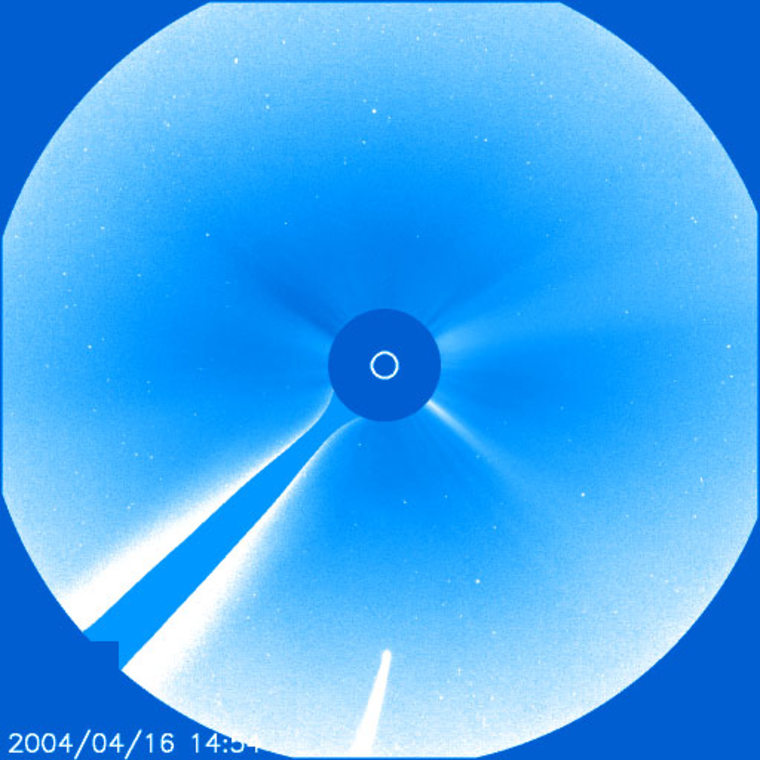It is a rare and challenging time for casual astronomers who wish to see comets. There are three right now in position to be spotted soon either from backyards or on the Internet, but it's not yet clear whether any of them will be easy targets for most observers.
The most recently discovered of these comets is called Bradfield. Late Thursday it became visible in web images captured by the Sun-watching SOHO spacecraft.
Comet Bradfield may be visible in the SOHO images through Monday, 4/19. And there's a chance it will emerge into the morning sky -- visible to the naked eye -- in late April.
Two other comets have been in astronomers' sights for month and are just preparing to possibly put on backyard shows.
Comet LINEAR
After many weeks of dawdling in the vicinity of the Sun, comet LINEAR (catalogued C/2002 T7) has begun to reappear in the early morning sky. Having been effectively out of sight for such a long interval, nobody knew exactly how this comet had been brightening en route toward a late-April rendezvous with the Sun.
The chief worry concerning comet LINEAR, as well as another comet that could evolve into a bright object (comet NEAT C/2001 Q4) is that they are both "new" comets – freshly arrived specimens from the outermost reaches of the solar system.
A new comet in a parabolic orbit – that is, one that has never passed near the Sun before – may have its surface covered with very volatile material such as frozen carbon dioxide, nitrogen, and carbon monoxide. These ices tend to vaporize far from the Sun, giving a distant comet a surge in brightness that can raise unrealistic expectations. In recent years such comets, such as C/2002 O7 (also known as LINEAR, for the search program that found both) have been observed to break up and completely disintegrate as they neared the Sun.
Other noteworthy cases of comets whose brightness unexpectedly ebbed as they neared the Sun included the infamous comet Kohoutek in 1973-74, comet Cunningham in 1940-41 and comet Austin in 1990.
All this doesn’t automatically mean that comet LINEAR will fizzle-out, since not all new comets become duds. Comet Arend-Roland is an outstanding exception, a first-timer that put on a spectacular show in April 1957.
Unfortunately, before LINEAR vanished into the solar glare during early March it appeared that it was following along the lines of Kohoutek, Cunningham and Austin, for its brightening almost completely stalled out from early February through early March.
Early opinions
"It is too soon to know all of the possible ramifications of this, but the rate of brightening has decreased," noted comet expert Gary Kronk.
German amateur astronomer Maik Meyer suspects the comet may be dropping back to the rate of brightening it experienced prior to the sudden change last October. If so, this will seriously affect the predictions -- and not in a favorable direction.
So what has been happening to comet LINEAR during the past month?
The first reported observation of it was made on the morning of April 9, by Alexandre Amorim of Florianopolis, Brazil. He spied the comet during mid-twilight, displaying a good central condensation and a magnitude of +4.6 -- just inside the range of visibility for most naked-eye viewers on a scale where lower numbers mean brighter objects.
We should get a better idea during this week as LINEAR continues to slowly emerge from the bright morning twilight. It should continue to slowly brighten as it approaches both the Sun and the Earth. It will arrive at perihelion – its closest point to the Sun – on April 23, at a distance of 57 million miles (92 million kilometers). After it moves around the Sun, it should continue to noticeably brighten as it approaches the Earth.
Unfortunately, for those in the Northern Hemisphere, comet LINEAR will be quite difficult to see, since it will hover very low near the eastern horizon about an hour before sunrise through the balance of April and on into the beginning of May. Northern observers might catch only a fleeting glimpse of LINEAR, possibly as bright as 2nd magnitude, in the brightening dawn twilight at the end of April or very beginning of May. The brightest stars and planets have zero or negative magnitudes.
Thereafter, the comet will move too far to the south to be visible from northern latitudes.
The situation for Southern Hemisphere viewers, in contrast, will be far better. While comet LINEAR will probably not become readily visible to most until mid-April, thereafter, it will appear to climb progressively higher each morning in the east-northeast sky.
During the first ten days of May, the comet should be an easy target for observers south of the equator, rising about 2 to 3 hours before sunrise.
Also during late April, Southern Hemisphere observers will have an unusual opportunity at dawn of seeing two naked-eye comets in the sky simultaneously. While LINEAR stands over the east-northeast horizon, comet NEAT will be visible low above the southeast horizon. During the final week of April, both comets could be shining at around 3rd magnitude.
Comet NEAT
These next several weeks will be critical for comet LINEAR as it sweeps through the inner solar system. Right now it appears that it will fall short of initial expectations of it reaching the rank of first magnitude. But this, of course, could still change; especially in the days immediately after it has made its closest pass to the Sun.
For the moment, however, second magnitude looks to be about as bright as it’s going to get.
In fact, for northern observers, if there’s any kind of a bright comet show to look forward to, it probably will not come from LINEAR, but from comet NEAT, which is still brightening on a steady pace that could also make it an easy second-magnitude object by early May
